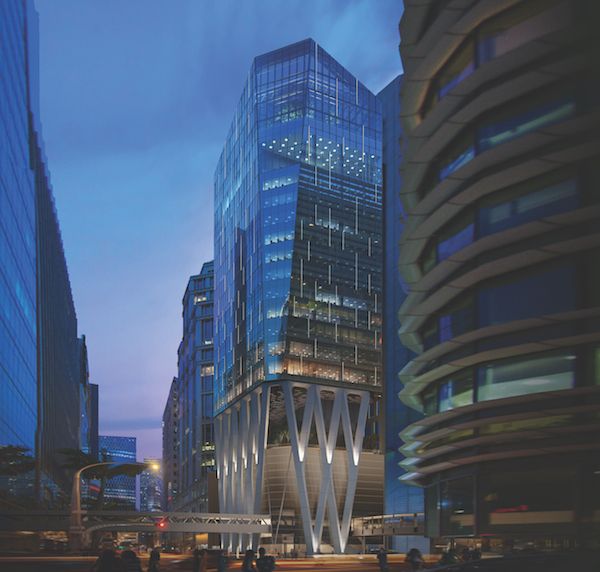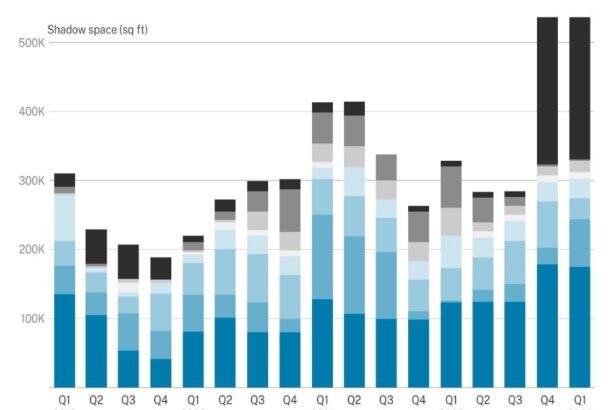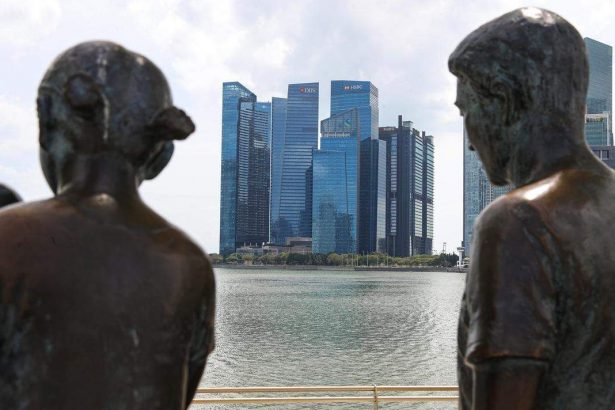The redevelopment of what was once one of the oldest buildings along Robinson Road into a new CBD landmark is taking shape quickly
One of the oldest buildings on Robinson Road is getting a new lease of life as the new Afro-Asia i-Mark Building. Located at the corner of Robinson Road and McCallum Street, the new 19-storey, Grade-A office tower at 63 Robinson Road is scheduled for completion in 2Q2020.
At the end of last month, the joint developers of the new Afro-Asia i-Mark Building signed on hospitality-based co-working operator The Great Room as an anchor tenant in a deal brokered by JLL, the exclusive leasing agent for the building.
The Great Room is taking up 37,000 sq ft of office space across the sixth to eighth levels, which translates to 26% of total net lettable area of 140,000 sq ft in the building. “It will be our largest in Singapore to date,” says Jaelle Ang, CEO and co-founder of The Great Room.
Afro-Asia i-Mark Building is jointly developed by the Tan family of Afro-Asia Shipping Co and Shimizu Corp at an estimated cost of $320 million. The Tans hold the majority stake in the joint venture.
‘Overdue for redevelopment’
Before it was torn down, the former Afro-Asia Building was known by those working in the CBD area as the building with the MPH Bookstore at the corner next to Uncle Sam’s Claypots restaurant. The original Afro-Asia Building was a seven-storey office building that was already 62 years old – with 37 years left on its lease – when it was torn down in 2017.
“It was definitely overdue for redevelopment, judging from the average building lifespan of 50 years,” says Tan Cheng Gay, on behalf of his family members who control Afro-Asia Shipping Co. “We decided to bring in some partners who shared our vision in terms of the design, led by Michael Ngu, managing partner of Architects 61,” he adds.
Shimizu Corp is not just a partner in the development but is also handling the construction of the building. Architects 61 is the appointed design architect, while KK Lim & Associates is the appointed lead engineer.
“We’ve decided to keep the old building name and added ‘i-Mark’ which symbolises new tech; that’s why the new building is named Afro-Asia i-Mark,” says Cheng Gay.
For Shimizu Corp, “i-Mark” is significant as it is the brand used to flag office buildings in Tokyo that are owned by the Japanese firm. “It’s a recognised brand in Japan,” says Brian Poon, senior manager, investment and development division, Shimizu Corp. “The building at 63 Robinson Road has ‘i-Mark’ in its name because Shimizu has a stake in the development. It is going to be the first ‘i-Mark’ branded building outside of Japan.”
Shimizu Corp is no stranger to Singapore, having constructed other landmark buildings such as Ngee Ann City, Republic Plaza, Tokio Marine Centre and Mapletree Business City.
Designed for flexibility
The building at 63 Robinson Road will feature floor plates averaging 12,249 sq ft. The offices will span the sixth to 17th levels.
On the fifth level is the sky garden, which will be operated by The Great Room as an event space and an added amenity for its members and other tenants in the building.
“I suspect the fifth-floor sky garden will be very popular,” says Shimizu’s Poon. “It’s accessible to all tenants in the building and open to the public.”
Another unique feature of the building is the “penthouse level” on the 17th floor. About 4,000 sq ft of the space has a double-volume ceiling height, which then tapers to about 3m for the rest of the space. “This is the highest office floor of the building and it offers an excellent 180-degree view of the sea on one side and Chinatown on the other,” says Tahlil Khan, JLL Singapore executive director of office leasing. “There’s a wow factor here, and we have received a lot of interest for that space.”
New tech, accessibility
The building has also been designed with new technology from Japan. For instance, the building will have chilled beam air-conditioning system, which so far in Singapore, has only been used at the National University of Singapore campus. “This system saves power and the temperature is comfortable as it doesn’t blow cold air down on people,” says Poon. “It’s also very flexible as there are four zones per floor; if there are people working late in one of the zones, they can turn on the air-conditioning for that particular zone and turn off the rest.”
From the tenant’s perspective, it is also very cost-effective in terms of energy savings, notes JLL’s Khan.
Toilet fittings within the building will come with Japanese bidet. There will be end-of-trip facilities, including shower facilities, on the fifth, 12th and 19th floors – the 19th floor is the rooftop of the building. There are also 52 bicycle racks on the second level. Car parking facilities will be state-of-the-art automated guided vehicle parking. “It’s a mechanical parking system using robots,” says Poon. “If a robot breaks down, we can just replace it. This is unlike the conventional automated caged system, where if there’s a breakdown, the whole carpark system freezes.”
The first-level lobby will have a 10m ceiling height. On the second level of the building, there will be sheltered pedestrian bridges connecting it to the building at 120 Robinson Road across Robinson Road; and 71 Robinson Road across McCallum Street.
Besides the existing Tanjong Pagar MRT Station on the East-West Line and the Telok Ayer MRT Station on the Downtown Line, there will be an upcoming Shenton Way MRT Station on the Thomson-East Coast Line, which is scheduled for completion in 2021.
It will be just a three-minute walk to the Shenton Way MRT Station via the pedestrian bridges on the second level, which will be fully sheltered, says JLL’s Khan. The 10-minute walk to the Tanjong Pagar MRT Station will also be fully sheltered, via the pedestrian bridges across buildings.
Asking rents ‘above $10 psf’
Asking rents at Afro-Asia i-Mark Building will be “above $10 psf per month”, says Shimizu’s Poon. The building was designed to be multi-tenanted to avoid “single-tenant risk”, he adds. He intends to target tenants such as “grown-up tech companies”, as well as small- and medium-sized multinational corporations. “We have designed the building with a lot of flexibility for tenants to reconfigure according to their needs,” he elaborates.
In addition to The Great Room, negotiations are underway with several parties for other floors within the building, says JLL’s Khan.
Average effective monthly rents for Grade-A office space in the CBD have increased for the last four consecutive quarters from an average of $10.25 psf in 4Q2018 to $10.81 psf in 3Q2019, according to JLL Research.
However, across the CBD, depending on the building, asking rents are currently “hovering in the $11 to $13 psf range”, observes Chris Archibold, JLL Singapore head of leasing. “Demand has come mainly from the tech sector and the flex space providers.” In the co-working space, Archibold notes that “the explosive growth of the last three years has stabilised to a more constant rate”.
‘Co-working here to stay’
The implosion of giant co-working operator WeWork’s IPO attempt laid bare the risks of the growth-at-all-costs business model and raised questions about the sustainability of the co-working segment.
“What people must remember is that WeWork is co-working, but co-working is not just WeWork,” says an industry player.
According to JLL’s Archibold, “co-working is here to stay”. He adds: “There may be some hiccups along the way, but by and large, there is demand from occupiers – whether it’s big multinationals or small occupiers.”
When considering relocating to a new building, more and more corporate occupiers are enquiring if there is a flexible space operator within the development, adds Archibold. “Most tenants have fixed leases in their existing buildings and what they want is flexibility; with about 80% of their premises on a fixed lease; and another 20% on a short-term or flexible arrangement, which will allow them to shrink or grow depending on their needs.”
As such, the intention was always to have a flexible space operator as an amenity within Afro-Asia i-Mark Building, adds Archibold.
The original seven-storey Afro-Asia Building was built in 1955. It had been the headquarters of the former Nanyang Siang Pau, which merged with Sin Chew Jit Poh in 1983 to form the current Lianhe Zaobao. In fact, the printing press was located on the second and third floors of the building; hence, the maximum loading for those floors was very high in order to support the heavy printing machines, recounts Cheng Gay.
Preserving the legacy
Afro-Asia Shipping Co was founded by Cheng Gay’s father, Tan Kiam Toen, in 1961. He purchased the building at 63 Robinson Road in 1967, which he renamed Afro-Asia Building. “It was the first commercial building of its kind along Robinson Road then,” relates Tan Chin Hoon, Cheng Gay’s youngest brother.
Their father had chosen the name “Afro-Asia” to commemorate the Afro-Asia Convention that was launched in Bandung, Indonesia, in April 1955, says Cheng Gay.
Kiam Toen, who passed away in 2008, was born in China in 1919. He left for Indonesia in 1935, where he set up a successful business. He moved to Singapore in the 1940s where he traded in commodities, especially in herbs and rubber.
He also founded SsangYong Cement (Singapore) Ltd in 1973 under a tripartite joint venture with DBS Bank and Korea-based SsangYong Cement, to manufacture and distribute cement, ready-mix concrete and other building materials in Singapore. In 2005, SsangYong Cement was renamed EnGro Corp. It has since expanded its operations to cover Malaysia, Korea and China. “He had vision and foresight,” Cheng Gay says of his father. “From trading, he branched into cement and other industries.”
Cheng Gay, who calls himself an engineer, is the chairman and CEO of EnGro Corp, which is listed on the Singapore Exchange. He was appointed director in 1973 and served as executive director before becoming the chairman and CEO.
Meanwhile, his youngest brother, Chin Hoon, is the director of Afro-Asia Shipping Co.
The Tan family wants to preserve some elements of the old Afro-Asia Building in the new building, for instance, the hand rail at the main entrance, the sky terrace and the roof garden. “We will keep some of these,” says Cheng Gay. For the Tan family, it was very important to maintain a majority stake in the building. “If we give up the controlling interest, then whatever dreams we have will not be fulfilled,” he adds.
Shimizu Corp has a rich history too. It was founded 215 years ago by Kisuke Shimizu, who started as a carpenter. To preserve the legacies of both Afro-Asia Shipping Co and Shimizu Corp, elements of carpentry and cement are incorporated into the design of the building, for instance, the concrete walls with cedar wood imprints in the lobby, says Poon. “The overall design is meant to represent a growing tree,” he adds. It also symbolises
By Edgeprop



